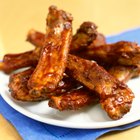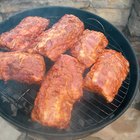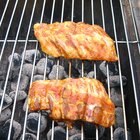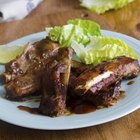
You can use wild boar to replace pork in most of your favorite recipes, including delicious, fall-off-the-bone ribs. Boar meat typically has a deeper, redder color and a richer, stronger flavor than that of pork. Because the meat is lean, similar to venison or bison, your best bet is to cook it relatively slowly at lower temperatures to prevent the meat from drying out and becoming tough. Throw your wild boar ribs in a slow cooker or on the grill to cook up a mouthwatering main dish with minimal fuss.
Grilling Wild Boar Ribs
Step 1
Trim any extra fat off the ribs and break them into smaller portions, if necessary, so that they fit into a large pot.
Step 2
Place the ribs in the pot and fill it with enough water to cover the ribs. Bring the pot to a slow boil, turn the heat down and put a lid on it.
Step 3
Simmer the ribs for roughly 25 minutes, until they are tender but the meat isn't falling off the bone. Parboiling the ribs cooks and tenderizes the meat before you throw it on the grill to sear the outside.
Step 4
Turn the grill on, setting the burners to medium, to preheat the grill. Brush the grates if necessary to eliminate any food residue before spraying the grates with cooking spray.
Step 5
Remove the ribs from the pot of water once they're done and the grill is heating up. Season them with salt and pepper or your favorite dry rub before basting them in barbecue sauce.
Step 6
Place the wild boar ribs on the grill and cook them for no more than six minutes, basting and turning them at least once while cooking.
Step 7
Check the meat for doneness by inserting an instant-read thermometer into the meatiest part of one of the ribs, away from the bone. It should read at least 160 degrees Fahrenheit.
Slow-Cooking Wild Boar Ribs
Step 1
Trim any excess fat from the wild boar ribs and cut them into two- or three-rib portions so that they fit into your slow cooker.
Step 2
Grab a bottle of your favorite pre-made barbecue sauce, or make your own. One sweet and tangy example combines onion, garlic, soy sauce, mustard, maple syrup, honey and beef broth. Put the sauce in the bottom of the slow cooker.
Step 3
Add the ribs to the slow cooker and use tongs to turn the ribs in the sauce until they're fully coated.
Step 4
Place the lid on your slow cooker and cook the ribs for three or four hours on high or seven to nine hours on low. Halfway through the cooking time, give the ribs a stir with a large spoon or rearrange them with your tongs to make sure that they cook evenly.
Step 5
Check for doneness using an instant-read thermometer that you insert in the meatiest part, away from the bone. The ribs are fully cooked once it reads at least 160 F.
Related Articles

How to Cook a Chuck Short Rib

How to Steam Pork Ribs

How to Cook Boneless Country Spare Ribs

How to Cook BBQ Pork Ribs Quickly

How to Quickly Cook Fork-Tender Ribs

How to Bake Spare Ribs Before BBQing

How to Smoke Ribs With a Gas Smoker

How Do I Cook Spare Ribs in an Electric ...

Should You Bake Barbecue Ribs Uncovered ...

How to Slow Cook Barbecue Ribs in a ...

How to Marinate & Dry Rub Beef Ribs

How to Cook Barbecue Deer in the Slow ...

The Best Way to Cook Pork Shoulder Ribs ...

How to Barbecue Ribs With a Gas Grill

How to Roast Italian Sausage

How to Make Perfect Lollipop Lamb Chops

How to Cook Pork Shoulder Western Ribs ...

How to Cook a Pork Spare Rib Brisket ...

How to Make Tender Marinated BBQ Pork ...
How to Smoke Baby Back Ribs
References
Tips
- Marinate the wild boar ribs to infuse it with flavor and help tenderize the meat, which can tend to be tough. Using a marinade with an acidic base, such as wine or pineapple juice, is effective in breaking down the muscle fibers in the meat, leaving you with succulent rib meat.
- Marinate the ribs overnight or up to two days in the refrigerator for the best results.
Writer Bio
Caryn Anderson combines extensive behind-the-scenes writing experience with her passion for all things food, fashion, garden and travel. Bitten by the travel bug at the age of 15 after a trip to Europe, Anderson fostered her love of style and fashion while living in New York City and earning her degree at New York University.
Photo Credits
Stockbyte/Stockbyte/Getty Images